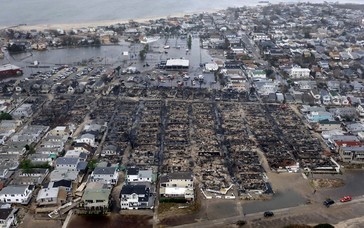|
2/11/2012 Just after Hurricane Sandy, a new report shows that North America has experienced the largest increases in weather-related economic loss eventsRead NowIzzy Braithwaite  As the US starts to pick up the pieces after the recent battering by Hurricane Sandy, many commentators have been discussing its relationship with climate change. Somehow, for the first time since 1984, climate change didn’t come up in any of the three American election debates, whilst Romney's effectively stated his intention to step up where he perceives Obama's failed - and become ''Mr. Oil or Mr. Gas or Mr. Coal'' - or more likely all three. So it comes as no surprise that the NY Mayor Michael Bloomberg has now come out against Romney's position and endorsed Obama on the basis of his environmental track record. Ok, so he may not have achieved much - but he sure stands a better chance of curbing carbon than Romney, who a few months ago got a 30-second applause for using climate change as a punchline. Of course, it is never possible to put single events down to climate change - but this new report released recently by the insurance group Munich Re about long term trends shows that shows that North America has been most affected by weather-related extreme events in recent decades (terms of economic losses - in general, far more lives are lost in poorer regions, due to lower adaptive capacity), and that climate change is part of the reason: ''For the period concerned – 1980 to 2011 – the overall loss burden from weather catastrophes was US $1060bn (in 2011 values).The insured losses amounted to US$ 510bn, and some 30,000 people lost their lives due to weather catastrophes in North America during this time frame.
... Among many other risk insights the study now provides new evidence for the emerging impact of climate change. For thunderstorm-related losses the analysis reveals increasing volatility and a significant long-term upward trend in the normalized figures over the last 40 years. These figures have been adjusted to account for factors such as increasing values, population growth and inflation. A detailed analysis of the time series indicates that the observed changes closely match the pattern of change in meteorological conditions necessary for the formation of large thunderstorm cells. Thus it is quite probable that changing climate conditions are the drivers. The climatic changes detected are in line with the modelled changes due to human-made climate change''. The relationship between climate and hurricane formation is complex: hurricanes aren't caused by climate change as such - the IPCC recently concluded in its SREX report that there is ‘low confidence’ in an observed long-term (40 years or more) increase in tropical cyclone activity – but there is good evidence that such storms are made stronger by its other effects: rising average sea and air temperatures due to climate change mean more moisture in the atmosphere resulting in heavier rain and climate change also drives rising sea levels which result in increased risk of storm surges. For every 1°C that the temperature of the air increases, it can hold 7% more moisture - increasing the potential for flooding. Moreover, Sandy's coincided with an extra-high tide, which increases the threat even further, and flooding has started even before the hurricane has reached. Yet in fact the impacts of natural disasters are some of the easiest health impacts of climate change to quantify. Determining the role of climate change in promoting the spread and (re)emergence of infectious diseases is dramatically more complex. In turn, investigation of how climate change is likely to affect food and water security or - further down the line, economic stability or conflict – is even more fraught with difficulties. The causal chain for such effects is so much more multi-dimensional, depending on so many variables, and the effects less visible - but they could potentially have much bigger effects on health, at least in the long term, than direct impacts of natural disasters. Here we can think of climate change, to some extent as with its effect on hurricanes, as a threat multiplier - and Hurricane Sandy is a call to action. Link to press release about the report: http://www.munichre.com/en/media_relations/press_releases/2012/2012_10_17_press_release.aspx
0 Comments
Your comment will be posted after it is approved.
Leave a Reply. |
Details
Archives
February 2019
Tags
All
|
 RSS Feed
RSS Feed
